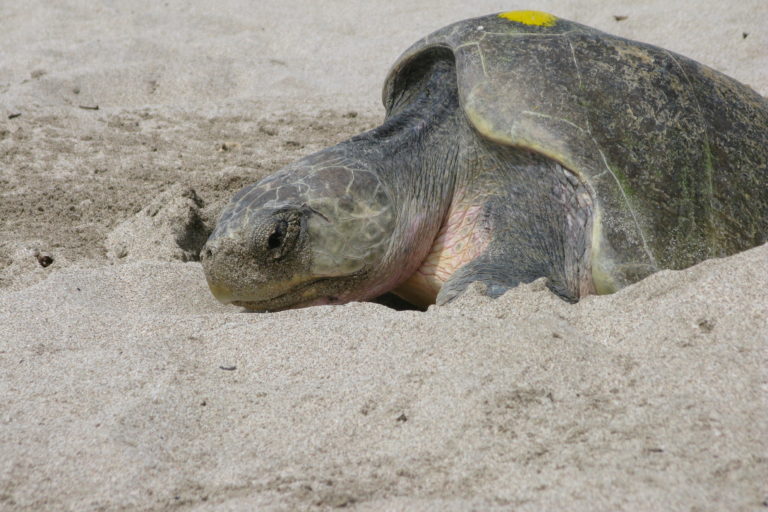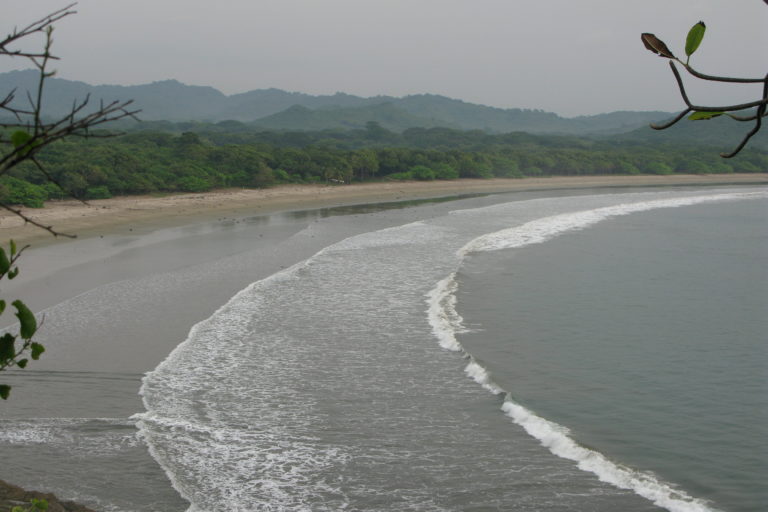- Residents of communities around Nicaragua’s La Flor Wildlife Refuge raided some 2,000 turtle nests and killed at least six turtles during the summer of 2018, a conservation NGO says.
- The scale of the theft was exacerbated by an ongoing political and security crisis that has left the refuge devoid of rangers and military patrols.
- The country’s first lady has launched an “I love turtles” media campaign, but critics are skeptical about how effective it will be.
Some 2,000 sea turtle nests were raided and at least six turtles killed in La Flor Wildlife Refuge on Nicaragua’s Pacific coast during the summer of 2018, according to a conservation NGO. Environmental and scientific organizations have condemned the scale of the raids, which were much larger than the usual episodes that occur on the country’s beaches, due to a lack of security stemming from a national political crisis.
Nicaragua has been in crisis condition since April 2018, when President Daniel Ortega announced a cut to social security benefits. The ensuing protests by citizens and response by government forces have left hundreds of people dead and hundreds more imprisoned, according to human rights groups. The Nicaraguan Association for Human Rights (ANPDH) reported that in just two days in July, 758 people were abducted or arrested by armed civilians and police.
“Many colleagues who work in natural resource conservation prefer to abstain from commenting to avoid endangering themselves and their families,” a source who requested anonymity told Mongabay Latam. “Any opinion against any state institution, even if not exclusively political, is considered an attack on the ruling party. It could result in threats or retaliation.”
During the turtle nesting season, the army and the Ministry of the Environment and Natural Resources (MARENA) normally guard the beach at La Flor. But the deployment of these forces to address the political unrest has left the refuge unprotected. Residents have taken advantage of the absence of soldiers and park rangers to go into the ocean and intercept the shore-bound turtles. Others have dug up the nests on the beaches and stolen the eggs.
The NGO Paso Pacífico runs a turtle conservation program in the Paso del Istmo biological corridor, the strip of land that sits between Lake Nicaragua and the Pacific Ocean.
Paso Pacífico told Mongabay Latam that around 1,000 people came to the beach and raided some 2,000 nests during the days of the arribada, or mass nesting event. Poachers also killed at least six turtles, according to the organization.
“The method they use is very cruel,” a representative from Paso Pacífico said. “They leave them for days upside down, or they pull off their shell or they bash in their heads.”

No security
The army’s General Command and Ecological Battalion usually maintains a permanent presence on nesting beaches in protected areas. In addition, a network of four to five park rangers ensures that, especially during the arribada, nesting takes place naturally with as little human interference as possible.
But given Nicaragua’s current political situation, “the small budget for conservation is not being used for that,” said another source who requested anonymity for safety reasons. “The money earmarked for city halls or ministries to purchase fuel for the patrols, for example, is now being used to purchase fuel to transport staff to pro-government protests.”
Jurguen Guevara, extractive industries officer at the Humboldt Center, an ecological research institute, agreed.
“[The crisis has led] to complaints that some public servants are forced to attend government rallies or protests,” Guevara said. “This may also be the case, though we, as the Humboldt Center, are not aware of it.”

“Before the crisis, the Ministry of the Environment was already barely present in the protected areas. There was little security with respect to the conservation and administration of natural resources,” Guevara said. “In the wake of the crisis, this situation has been greatly aggravated. If the oversight agencies were not present then, now they are even less [so].”
Guevara said this lack of monitoring had created greater pressure on nature as a whole, and it was affecting the turtles.
“We have observed trawlers less than a kilometer off the coast,” the anonymous source said. “Boats [are] unloading species that are prohibited or in some way regulated at the San Juan del Sur port. We saw a small-scale fishing boat completely full, just overflowing with oysters with no kind of control or supervision.
“The sea turtles attract attention because they are charismatic animals, because they come to the beach,” the source added. “But the situation is critical for many of Nicaragua’s marine resources.”
Egg poaching: An entrenched practice
Culturally, turtle eggs have long been a food source for the Pacific communities living around the protected areas and nesting beaches. The Ministry of the Environment briefly implemented a program, now defunct, to allow a limited turtle egg harvest. The objective was to encourage the community to protect the beaches and ensure optimal conditions for the turtles to lay eggs. In exchange, community members would receive a percentage of the eggs after the arribadas had finished.
“There was no follow up to the delivery plans,” Guevara said. “So, sometimes [the ministry] gave them a lot, others they gave them nothing. As a result, the communities continued with their habit of raiding nests, instead of waiting for the authorities to give them their quota.”

Paso Pacífico notes that even though egg extraction has always been a custom among communities on the Pacific coast, the raid last summer was different.
“In addition to being a large-scale, out-of-the-ordinary raid, we had never seen turtles killed before,” the organization said. “There is no tradition of eating turtle meat in this part of the country, unlike on the Atlantic coast of Nicaragua, where it is a [common] practice.”
The danger of a lost generation
Of the eight species of sea turtles on Earth, five come to lay eggs on Nicaragua’s beaches. The most common are the olive ridley sea turtle (Lepidochelys olivacea) and, to a lesser extent, the leatherback sea turtle (Dermochelys coriacea).
The olive ridley sea turtle deposits between 80 and 100 eggs per nest. Not all of the baby turtles that hatch reach the sea. Many die on the beach, devoured by predators. Those that survive must wait up to 20 years to reproduce for the first time; when it’s their turn to lay eggs, they return to the beach where they were born. That fact, combined with the special conditions that the turtles require, makes their reproductive cycle very fragile, Guevara said.
“If conditions at the beach that they have historically come to are inadequate, they simply do not lay eggs,” he said.

The turtles lay eggs from August through October, when the largest arribadas are expected. The beach at La Flor has recorded up to 80,000 turtles in just three to four days in October.
Conditions on the beach have to be just right for success. Because the turtles come ashore at night, the beaches must be sufficiently dark. Too much light can disorient the turtles so that they’re not able to find the beach. If that happens, the turtles end up laying eggs in the sea, where they never hatch. Too many tourists on the beach can also disturb the process.
The turtles move slowly on land, Guevara said, so “leaving the water, coming onto the beach, checking that conditions are adequate, and digging a nest at least 40 centimeters [16 inches] deep takes them about an hour and a half.”
After a two-hour laying session, the mother turtle covers the eggs with sand and then makes her way back to the water.
“In just one night, in about four or six hours, she will have completed the process,” Guevara said.
That’s enough time for poachers to raid thousands of eggs, culling turtles from a new generation that will never see the light of day.

In August, Nicaragua’s vice president and first lady, Rosario Murillo, launched an “I love turtles” media campaign. “Our culture makes it difficult, but it is our obligation to carry out this campaign and call on families to conserve them and not capture them, not sell them,” she said as reported by the pro-government newspaper 19 Digital.
“We are waiting for the next arribada,” a source told Mongabay in response to Murillo’s pledge, “and we will see if the vice president’s words will be effective and guarantee the sea turtles’ survival.”
Banner image courtesy of Paso Pacífico.
